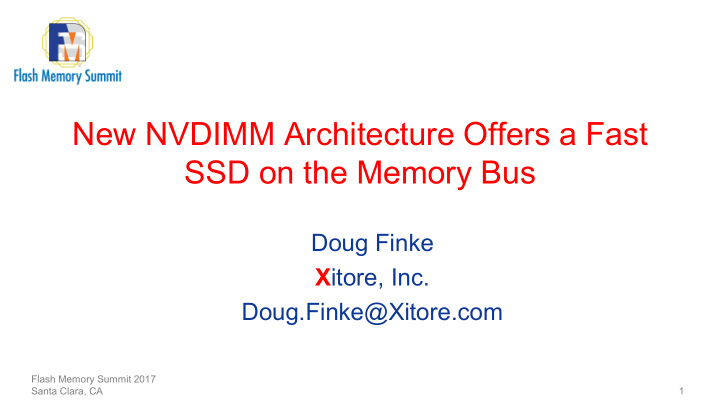



New NVDIMM Architecture Offers a Fast SSD on the Memory Bus Doug Finke X itore, Inc. Doug.Finke@Xitore.com Flash Memory Summit 2017 Santa Clara, CA 1
Moving Storage Interface to the DRAM Bus Will Be the Next Major Change The bus interface is increasing becoming the largest performance bottleneck in a system. Moving persistent storage to the DRAM bus has significant advantages • 3X raw speed advantage over NVMe 3.0 x8 • Opportunity to use byte access instead of block access • Use of direct access (DAX) mode for significant reductions in software overheads Flash Memory Summit 2017 Santa Clara, CA 2
Challenges with Existing DRAM Bus Current DRAM bus is Deterministic • Cannot handle variable access times • Cannot handle mixed media • Cannot handle execution out-of-order Addressing Limitations • DDR4 bus limited to 512GB or less Flash Memory Summit 2017 Santa Clara, CA 3
Long Term Solution: NVDIMM-P Protocol for DRAM Bus Non-deterministic access with out-of-order completion Posted store model using write credits Address bus expansion Mixed media of various types Both cached and non-cached accesses Example of Out-of-Order Execution with Cached and Non-Cached Accesses Flash Memory Summit 2017 Santa Clara, CA 4
NVDIMM-P Implementation Status JEDEC developing full spec to be released in 2018 • NVDIMM Task Group includes representatives from dozens of companies including all major microprocessor, NAND, and DRAM vendors • DDR4: Extension to current spec using two additional control lines (replacing ODT1 & CKE1 on connector) • DDR5: Built into main spec Will be ideal vehicle for Persistent Memory One catch: Requires new microprocessors to implement new control protocols; Won’t work with legacy systems Flash Memory Summit 2017 Santa Clara, CA 5
Solution: NVDIMM-P with Additional Backwards Compatibility Mode Implement flash on the memory bus Block mode only in this mode Requires a device driver, but no application change SSD commands, status, and data passed back and forth as READs and WRITEs on the DRAM bus Xitore calls this an NVDIMM-X or NVDIMM-P+ Flash Memory Summit 2017 Santa Clara, CA 6
Xitore’s NVDIMM-P Implementation with Backwards Compatibility Mode Tiered, heterogeneous memory on the NAND NAND same DIMM NAND NAND • Both fast and slow memory connected in a cache architecture NAND NAND Private on-DIMM memory bus between NAND NAND the fast and slow memories Data Read Write • Doesn’t tie up the main memory bus for Controller line fetches and cast-outs Implements a command queuing capability like HDDs DRAM DRAM • Helps hide latencies when there is a cache miss Flash Memory Summit 2017 DRAM DRAM Santa Clara, CA
How NVDIMM-X Works System configured with new device driver and NVDIMM module • No additional App, BIOS, OS or Hardware changes are needed Device driver and module communicate commands, status, and data through standard 64 byte DDR4 packets Guarantees deterministic response for legacy microprocessors Command queueing is supported with up to 128 commands in the queue. • All read and write requests contain a command ID • Since address communicated within the 64 byte data packet rather than the standard DDR4 address bus, a full 64 bits of addressability is available. Flash Memory Summit 2017 Santa Clara, CA
NVDIMM-X Driver Flowchart When device driver issues a command, module will always respond deterministically with a status, i.e. Ready or Not Ready • Status of all 128 possible commands communicated at once in 64 byte packet When status for a transaction is Ready, data is transferred to the host microprocessor Flash Memory Summit 2017 Santa Clara, CA
Summary - Advantages of NVDIMM-X Can be used with existing microprocessors Solves addressability limit issue • Addresses sent over 64 bit data bus using a WRITE command Same hardware module can be used as NVDIMM-P in byte mode when appropriate microprocessors become available Provides significant performance improvement over NVMe without requiring a change to the microprocessor or application Flash Memory Summit 2017 Santa Clara, CA 10
Thank-You! Flash Memory Summit 2017 Santa Clara, CA 11
Recommend
More recommend